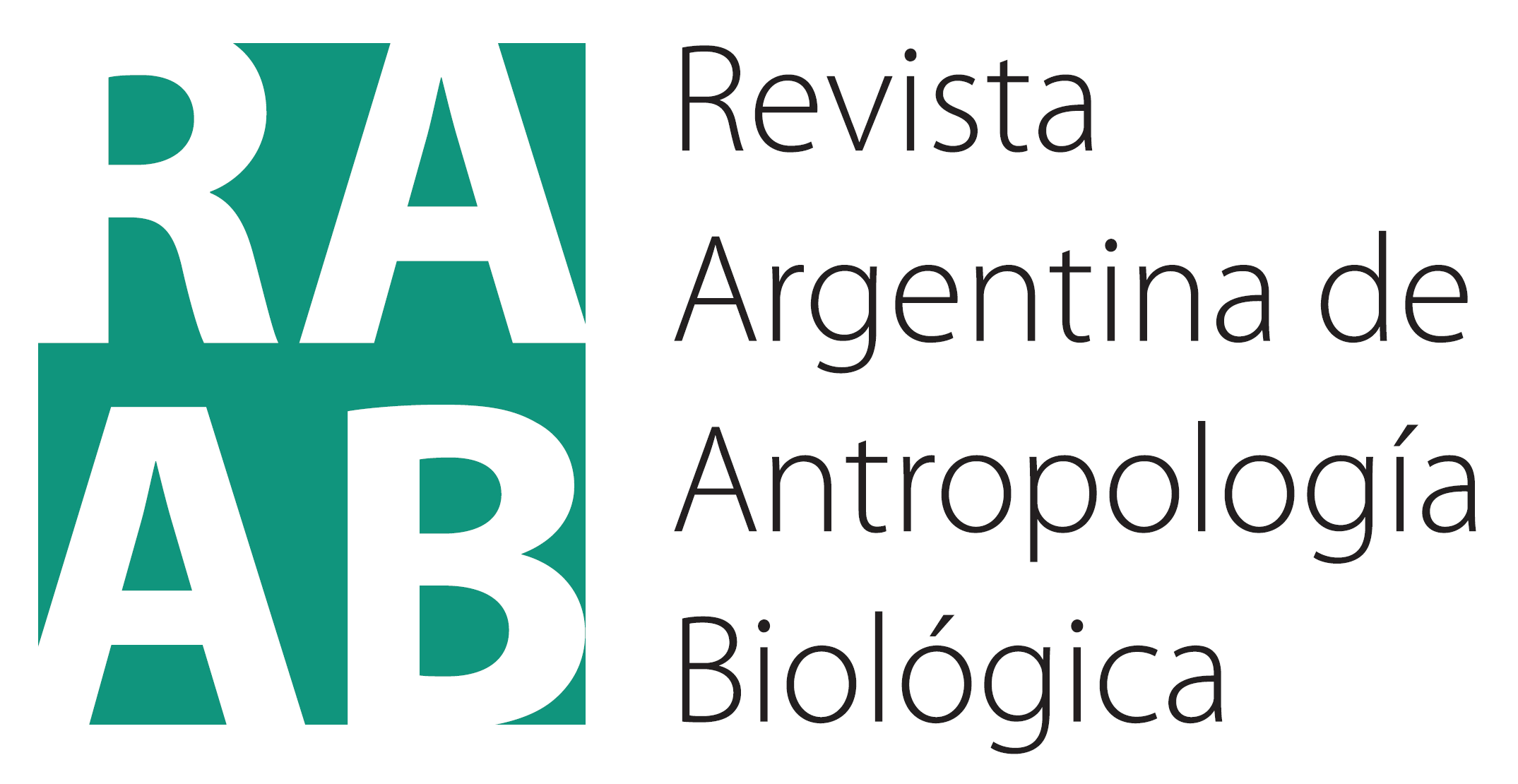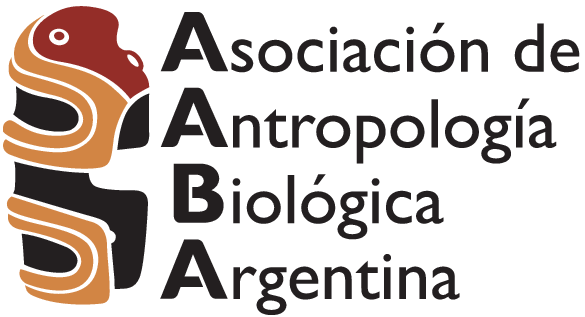Sexual dimorphism analysis in permanent human mandibular canines by geometric morphometrics
DOI:
https://doi.org/10.24215/18536387e075Keywords:
forensic odontology, human remains, morphometrics, sex estimationAbstract
Sex estimation of unknown human remains is a common form of assessment in bioarchaeological and forensic practice. When remains are poorly preserved, teeth become important. Research regarding the use of teeth for sex estimation mainly uses odontometrics. Nevertheless, to date, few studies have aimed to systematically evaluate sexual dimorphism in tooth shape. The purpose of this study is to analyze and describe sexual dimorphism in the mandibular canine. Landmarks and semilandmarks were placed on the occlusal, mesiodistal and buccolingual views of mandibular canines of 56 individuals (37 males and 19 females) from the “Prof. Dr. Rómulo Lambre” collection. Moreover, the impact of dental wear in morphometric analyses on sexual dimorphism was explored. The shape of male and female canines differed significantly in the three views analyzed. Female canines showed a larger crown in relation to its root, while male canines showed greater roots in relation to their crown. While female canines showed a large development of the cingulum, male’s teeth exhibited less development of this trait. For these reasons, this study constitutes a first approach to show the usefulness of shape for estimating the sex of canine teeth. These differences might be the result of dissimilarities in the total amount of dentin and enamel due to the effect of sex-linked genes in the growth of these tissues.
Downloads
Metrics
References
Acharya, A. B., & Mainali, S. (2007). Univariate sex dimorphism in the Nepalese dentition and the use of discriminant functions in gender assessment. Forensic Science International, 173(1), 47-56. https://doi.org/10.1016/j.forsciint.2007.01.024
Alvesalo, L. (1971). The influence of sex-chromosome genes on tooth size in man. A genetic and quantitative study. American Journal of Orthodontics, 60(4), 420. https://doi.org/10.1016/0002-9416(71)90160-6
Alvesalo, L. (1997). Sex chromosomes and human growth. A dental approach. Human Genetics, 101, 1-5. https://doi.org/10.1007/s004390050575
Alvesalo, L. (2009). Human sex chromosomes in oral and craniofacial growth. Archives of Oral Biology, 54(1), S18-S24. https://doi.org/10.1016/j.archoralbio.2008.06.004
Alvesalo, L., Osborne, R., & Kari, M. (1977). The 47,XYY male, Y Chromosome and tooth size: A preliminary communication. In A. Dahlberg & T. Graber (Ed.), Orofacial Growth and Development (pp. 109-118). De Gruyter Mouton. https://doi.org/10.1515/9783110807554.109
Alvesalo, L., & Tammisalo, E. (1981). Enamel thickness in 45,X females permanent teeth. American Journal of Human Genetics, 33(3),464-9.
Alvesalo, L., Tammisalo E., & Townsend, G. (1991). Upper central incisor and canine tooth size crown in 47, XXY males. Journal of Dental Research, 70(7), 1057-1060. https://doi.org/10.1177/00220345910700070801
Anuthama, K., Shankar, S., Ilayaraja, V., Shiva Kumar, G., Rajmohan, M., & Vignesh, M. (2011). Determining dental sex dimorphism in South Indians using discriminant functions analysis. Forensic Science International, 212(1-3), 86-89. https://doi.org/10.1016/j.forsciint.2011.05.018
Aranda, C., Barrientos, G., & Del Papa, M. (2014). Código deontológico para el estudio, conservación y gestión de restos humanos de poblaciones del pasado. Revista Argentina de Antropología Biológica, 16(2), 111-113. https://doi.org/10.17139/raab.2014.0016.02.05
Banarjee, A., Kmath, V. V., Satelur, K., Rajkumar, K., & Sundaram, L. (2016). Sexual dimorphism in tooth morphometrics: An evaluation of the parameters. Journal of Forensic Dental Sciences, 8(1), 22-27.
Bañuls, I., Catalá, M., & Plasencia, E. (2014). Estimación del sexo a partir del análisis odontométrico de los caninos permanentes. Revista Española de Antropología Física, 35, 1-10.
Bernal, V. (2007). Size and shape analysis of human molars: Comparing traditional and geometric morphometric techniques. HOMO-Journal of Comparative Human Biology, 58(4), 279-296. https://doi.org/10.1016/j.jchb.2006.11.003
Bernal, V., Gonzalez, P. N., Perez, S. I., & Del Papa, M. (2004). Evaluación del error intraobservador en bioarqueología. Intersecciones en Antropología, 5, 129-140.
Bookstein, F. L. (1991). Morphometric Tools for Landmark Data. Geometry and Biology. Cambridge University Press. https://doi.org/10.1017/CBO9780511573064
Bookstein, F. L. (1997). Landmark methods for forms without landmarks: Morphometrics of group differences in outline shape. Medical Image Analysis, 1(3), 225-243. https://doi.org/10.1016/S1361-8415(97)85012-8
Bookstein, F. L., Streissguth, A. P., Sampson, P. D., Connor, P. D., & Barr, H. M. (2002). Corpus callosum shape and neuropsychological deficits in adult males with heavy fetal alcohol exposure. NeuroImage, 15(1), 233-251. https://doi.org/10.1006/nimg.2001.0977
Christensen A. M., Passalacqua N. V., & Bartelink E. J. (2014). Forensic Anthropology. Current Methods and Practice. Academic Press.
Cucina A., Price D. T., Magaña Peralta, E., & Sierra Sosa T. (2015). Crossing the peninsula: The role of the Noh Bec, Yucatan, in Ancient Maya Classic Period population dynamics from an analysis of dental morphology and Sr isotopes. American Journal of Human Biology, 27(6), 767-778. https://doi.org/10.1002/ajhb.22749
Ferrario, V. F., Sforza, C., Tartaglia, G. M., Colombo, A., & Serrao, G. (1999). Size and Shape of the human first permanent molar: A Fourier analysis of the occlusal and equatorial outlines. American Journal of Physiological Anthropology, 108(3), 281-294.
Garizoain, G. (2019). Patrones estructurales en dentición permanente humana como predictores de edad y sexo. Análisis de una colección osteológica documentada [Unpublished Doctoral Thesis]. University of La Plata. http://sedici.unlp.edu.ar/handle/10915/77402
Garizoain, G., Petrone, S., García Manuso, R., Plischuk, M., Desántolo, B., Inda, A.M., Errecalde, A. L., & Salceda, S. A. (2018, October 25-26). Análisis de dimorfismo sexual de piezas dentarias permanentes en una colección osteológica documentada. XIX Congreso de Ciencias Morfológicas y 17avas Jornadas de Educación de la Sociedad de Ciencias Morfológicas de La Plata, La Plata, Argentina.
Garn, S. M., Kerewsky, R. S., & Swindler, D. R. (1966). Canine “Field” in sexual dimorphism of tooth size. Nature, 212, 1501-1502. https://doi.org/10.1038/2121501b0
Garn, S. M., Lewis, A. B, Swindler, D. R., & Kerewsky, R. S. (1967). Genetic control of sexual dimorphism in tooth size. Journal of Dental Research, 46(5), 963-972. https://doi.org/10.1177/00220345670460055801
Ghandi, N., Jain, S., Kahlon, H., Singh, A., Singh Gambhir, R., & Gaur, A. (2017). Significance of mandibular canine index in sexual dimorphism and aid in personal identification in forensic odontology. Journal of Forensic Dental Sciences, 9(2), 56-60.
Graziano, V., Cumbo, V., & Messian, P. (1984). Analisi statistica dei valori medi dei diametri mesiodistadi, dello spessore dello smalto e della dentina nei denti permanenti. Stomatologia Mediterranea, 4, 3-20.
Isçan, M. Y., & Kedici, P. S. (2003). Sexual variation in bucco-lingual dimensions in Turkish dentition. Forensic Science International, 137(1-2), 160-164. https://doi.org/10.1016/S0379-0738(03)00349-9
Kazzazi, S. M., & Kranioti, E. F. (2017). A novel method for sex estimation using 3D computed tomography models of roots: A volumetric analysis. Archives of Oral Biology, 83, 202-208. https://doi.org/10.1016/j.archoralbio.2017.07.024
Khamis, M. F., Taylor, J. A., Malik, S. N., & Townsend G. C. (2014). Odontometric sex variation in Malaysians with application to sex prediction. Forensic Science International, 234, 183.e1-138.e7. https://doi.org/10.1016/j.forsciint.2013.09.019
Kieser, J. A., Bernal, V., Waddell, J. N., & Raju. S. (2007). The uniqueness of the human anterior dentition: A geometric morphometric analysis. Journal of Forensic Sciences, 52(3), 671-677. https://doi.org/10.1111/j.1556-4029.2007.00403.x
Klingenberg, C. P. (2011). MorphoJ: An integrated software package for geometric morphometrics. Molecular Ecology Resources, 11(2), 353-357. https://doi.org/10.1111/j.1755-0998.2010.02924.x
Lähdesmäki, R. (2006). Sex chromosomes in human tooth growth. Radiographic studies on 47,XYY males, 46,XY females, 47, XXY males and 45,X/46,XX females [Unpublished Doctoral Thesis]. University of Oulu, Finland. https://urn.fi/URN:ISBN:9514281705
Lähdesmäki, R., & Alvesalo, L. (2004). Root lengths in 47, XYY males permanent teeth. Journal of Dental Research, 83(10), 771-775. https://doi.org/10.1177/154405910408301007
Lähdesmäki, R., & Alvesalo, L. (2005). Root growth in the teeth of 46,XY females. Archives of Oral Biology, 50(11), 947-952. https://doi.org/10.1016/j.archoralbio.2005.03.002
López-Lazaro, S., Alemán, I., Irurita, J., & Botella, M. C. (2020). Sexual dimorphism of the maxillary postcanine dentition: A geometric morphometric analysis. HOMO-Journal of Comparative Human Biology, 71(4), 259-271. http://doi.org/10.1127/homo/2020/1170
Luna, L. H. (2019). Canine sex estimation and sexual dimorphism in the collection of identified skeletons of the University of Coimbra, with an application in a Roman cemetery from Faro, Portugal. International Journal of Osteoarchaeology, 29(2), 260-272. https://doi.org/10.1002/oa.2734
Perez, S. I., Bernal, V., & González P. N. (2006). Differences between sliding semi-landmark methods in geometric morphometrics, with an application to human craniofacial and dental variation. Journal of Anatomy, 208(6), 769-784. https://doi.org/10.1111/j.1469-7580.2006.00576.x
Pettenati-Soubayroux, I., Signoli, M., & Dutour, O. (2002). Sexual dimorphism in teeth: Discriminatory effectiveness of permanent lower canine size observed in a XVIIIth century osteological series. Forensic Science International, 126(3), 227-232. https://doi.org/10.1016/S0379-0738(02)00080-4
Plavcan, J. M. (2001). Sexual dimorphism in primate evolution. American Journal of Physical Anthropology, 116(S33), 25-53. https://doi.org/10.1002/ajpa.10011
Polychronis, G., Christou, P., Mavragani, M., & Halazonetis, D. J. (2013). Geometric Morphometric 3D shape analysis and covariation of human mandibular and maxillary first molars. American Journal of Physical Anthropology, 152(2), 186-196. https://doi.org/10.1002/ajpa.22340
Popovici M., Groza V., Bejenaru L., & Petraru O. (2022). Geometric morphometrics of the second molar teeth within the human population from the late medieval city of Iași, Romania. Archaeometry, 64(6), 1479-1498. https://doi.org/10.1111/arcm.12790
Prabhu, S., & Acharya, A. B. (2009). Odontometric sex assessment in Indians. Forensic Science International, 192(1-3), 129.e1-129.e5. https://doi.org/10.1016/j.forsciint.2009.08.008
R Development Core Team. (2020). R: A language and environment for statistical computing (Version 4.0.3) [Computer Software]. R Foundation for Statistical Computing. https://www.r-project.org
Rohlf, F. (2017). tpsDig2: Data acquisition program (Version 2.31) [Computer Software]. Department of Ecology and Evolution, State University of New York. https://www.sbmorphometrics.org/soft-tps.html
Rohlf, F. (2019). Relative warps analysis (Version 1.70) [Computer Software]. Department of Ecology and Evolution, State University of New York. https://www.sbmorphometrics.org/soft-tps.html
Rohlf, F., & Slice, D. E. (1990). Extensions of the procrustes method for the optimal superimposition of landmarks. Systematic Biology, 39(1), 40-59. https://doi.org/10.2307/2992207
Saunders, S. R., Chan, A. H. W., Kahlon, B., Kluge, H. F., & FitzGerald, C. M. (2007). Sexual dimorphism of the dental tissues in human permanent mandibular canines and third premolars. American Journal of Physical Anthropology, 133(1), 735-740. https://doi.org/10.1002/ajpa.20553
Schwarz, G. T., & Dean, M. C. (2005). Sexual dimorphism in modern human permanent teeth. American Journal of Physical Anthropology, 128(2), 312-317. https://doi.org/10.1002/ajpa.20211
Smith, B. H. (1984). Patterns of molar wear in hunter-gatherers and agriculturalists. American Journal of Physical Anthropology, 63(1), 39-56. https://doi.org/10.1002/ajpa.1330630107
Stroud, J. L., Buschang, P. H., & Goaz, P. W. (1994). Sexual dimorphism in mesiodistal dentin and enamel thickness. Dentomaxillofacial Radiology, 23(3), 169-171. https://doi.org/10.1259/dmfr.23.3.7835519
Viciano, J. (2013). Métodos odontométricos para la estimación del sexo en individuos adultos y subadultos [Unpublished Doctoral Thesis]. University of Granada, Spain. http://hdl.handle.net/10481/23983
Viciano, J., D’Anastasio, R., & Capasso, L. (2015) Odontometric sex estimation on three populations of the iron age from Abruzzo region (central-southern Italy). Archives of Oral Biology, 60(1), 100-115. https://doi.org/10.1016/j.archoralbio.2014.09.003
Viciano, J., López-Lazaro, S., & Alemán, I. (2013) Sex estimation based on deciduous and permanent dentition in a contemporary Spanish population. American Journal of Biological Anthropology, 152(1), 31-43. https://doi.org/10.1002/ajpa.22324
Vodanović, M., Demo, Z., Njemirovskij, V., Keros, J., & Brkić, H. (2007) Odontometrics: A useful method for sex determination in an archaeological skeletal population? Journal of Archaeological Science, 34(6), 905-913. https://doi.org/10.1016/j.jas.2006.09.004
Yamada, E., Hongo, H., & Endo, H. (2021). Analyzing historic human-suid relationships through dental microwear texture and geometric morphometric analyses of archaeological suid teeth in the Ryukyu Islands. Journal of Archaeological Science, 132, 105419. https://doi.org/10.1016/j.jas.2021.105419
Downloads
Published
How to Cite
Issue
Section
License
Copyright (c) 2024 Gonzalo Garizoain, Virginia CobosThe RAAB is a diamond-type open access journal. There are no charges for reading, sending or processing the work. Likewise, authors maintain copyright on their works as well as publication rights without restrictions.




























